Abstract
1. The cardiovascular responses to intravenous (i.v.) injection of natural tachykinins, substance P (SP), neurokinin A (NKA), neurokinin B (NKB) and selective tachykinin (NK) receptor agonists, [Sar9, Met(O2)11]SP, [beta Ala8]NKA(4-10), [MePhe7]NKB and senktide were assessed in conscious, freely moving, guinea-pigs. 2. SP and [Sar9, Met(O2)11]SP (1-1000 pmol kg-1) induced dose-dependent decreases in mean arterial blood pressure (MAP) accompanied by increases in heart rate (HR). NKA evoked only weak hypotensive effects at high doses (3000 pmol kg-1) whereas [beta Ala8]NKA(4-10) (1-3000 pmol kg-1) had no effects. By contrast, NKB [MePhe7]NKB (1-10,000 pmol kg-1) and senktide (1-1000 pmol kg-1), produced dose-related hypertensive effects with the following rank order of potency: senktide > [MePhe7]NKB > NKB. Bradycardia occurred simultaneously with the increases in arterial pressure. 3. The pressor response to intravenous injection of senktide (300 pmol kg-1) was partially reduced by pretreatment with prazosin (0.71 mumol kg-1), or clonidine (0.38 mumol kg-1) and was completely inhibited by the combination of the two compounds. Atropine (1.5 mumol kg-1) suppressed the decrease in HR induced by senktide without altering the blood pressure response. These findings suggest that the blood pressure response to senktide is an indirect effect mediated by noradrenaline released from sympathetic nerve endings, whereas the bradycardia is of vagal reflex origin. 4. SR 142801, ((S)-(N)-(1-(3-(1-benzoyl-3-(3,4-dichlorophenyl) piperidin-3-yl) propyl)-4-phenyl-piperidin-4-yl)-N-methylacetamide), a potent and specific non-peptide NK3 receptor antagonist dose-dependently (0.46-4.6 mumol kg-1, i.v.; 4.6-46 mumol kg-1, p.o.) inhibited the cardiovascular effects of senktide and displayed a long-lasting inhibitory effect after oral administration. By contrast, SR 142806 (4.6 mumol kg-1, i.v.), the (R)-enantiomer of SR 142801 had no effect on the responses to senktide. SR 142801 at a high dose (15 mumol kg-1, i.v.) was inactive toward the [Sar9, Met(O2)11]SP-induced hypotension. 5. SR 142801 did not modify MAP in conscious guinea-pigs both after i.v. (4.6 and 15 mumol kg-1) and oral (46 and 150 mumol kg-1) administration, showing a lack of agonistic properties. However, a slight reduction in HR was observed only after i.v. injection. 6. In conclusion, these results show evident differences in the functional role of tachykinin receptors in the peripheral control of the cardiovascular system. Furthermore, a clear pressor effect of senktide, which was selectively blocked by SR 142801, was observed in conscious guinea-pigs. Hence, this antagonist appears suitable for investigating the functional role of NK3 receptors.
Full text
PDF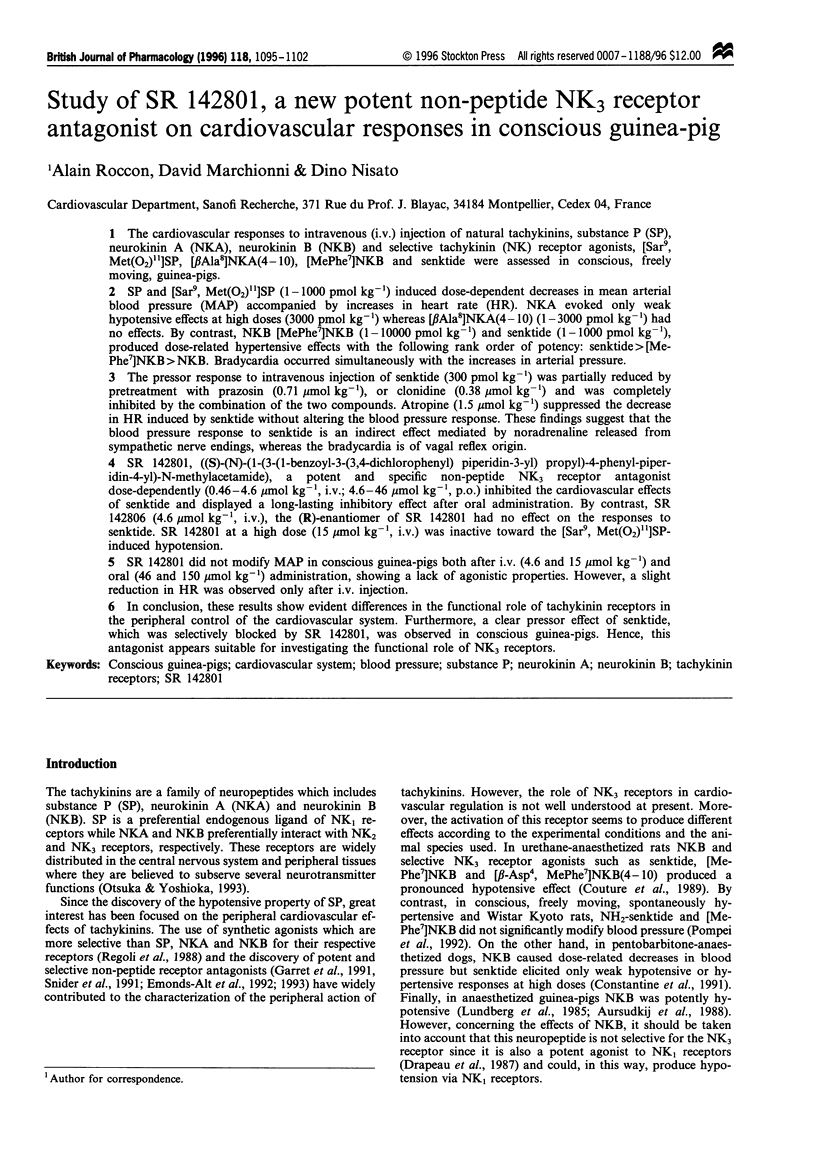
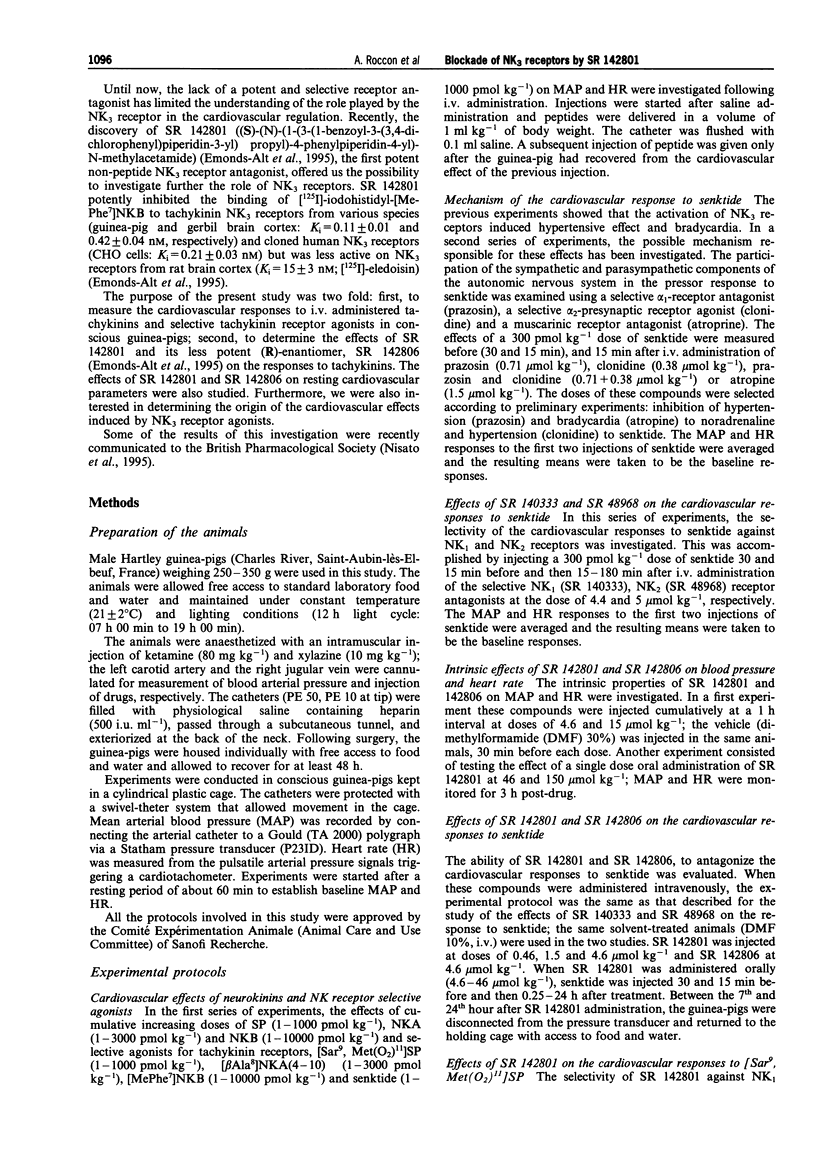
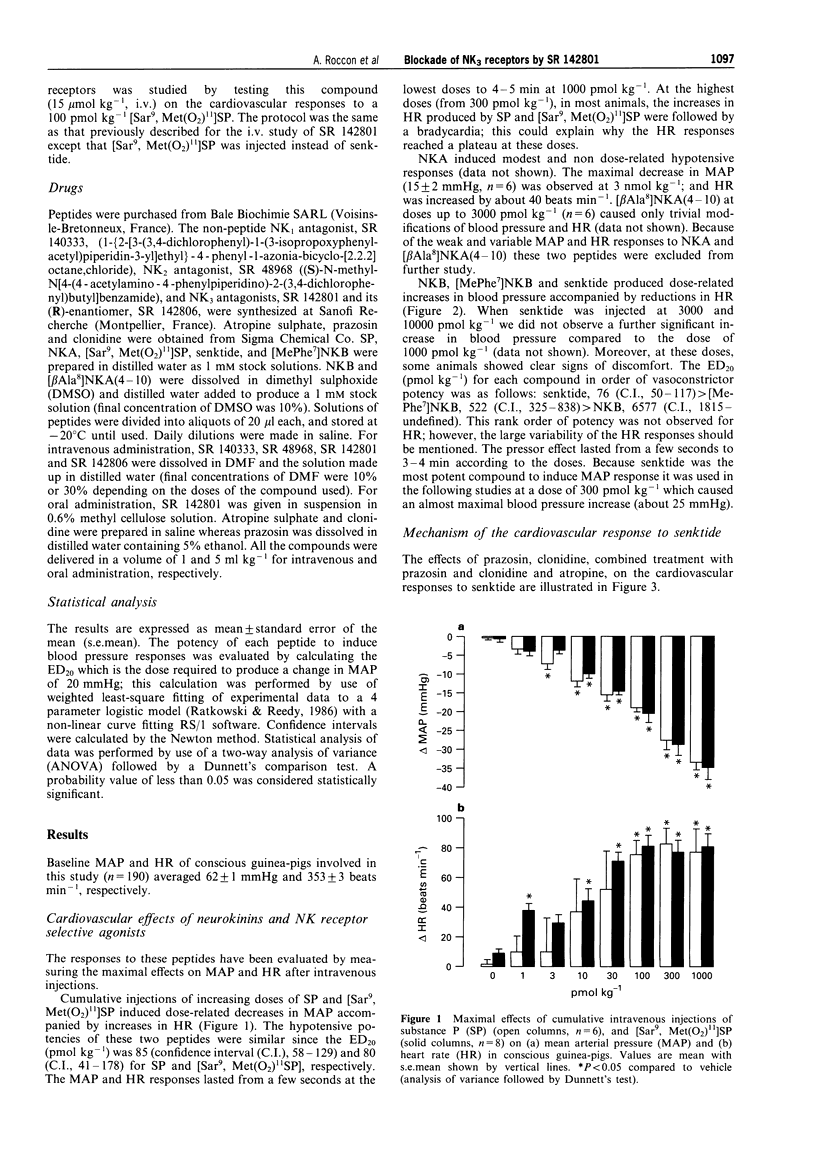
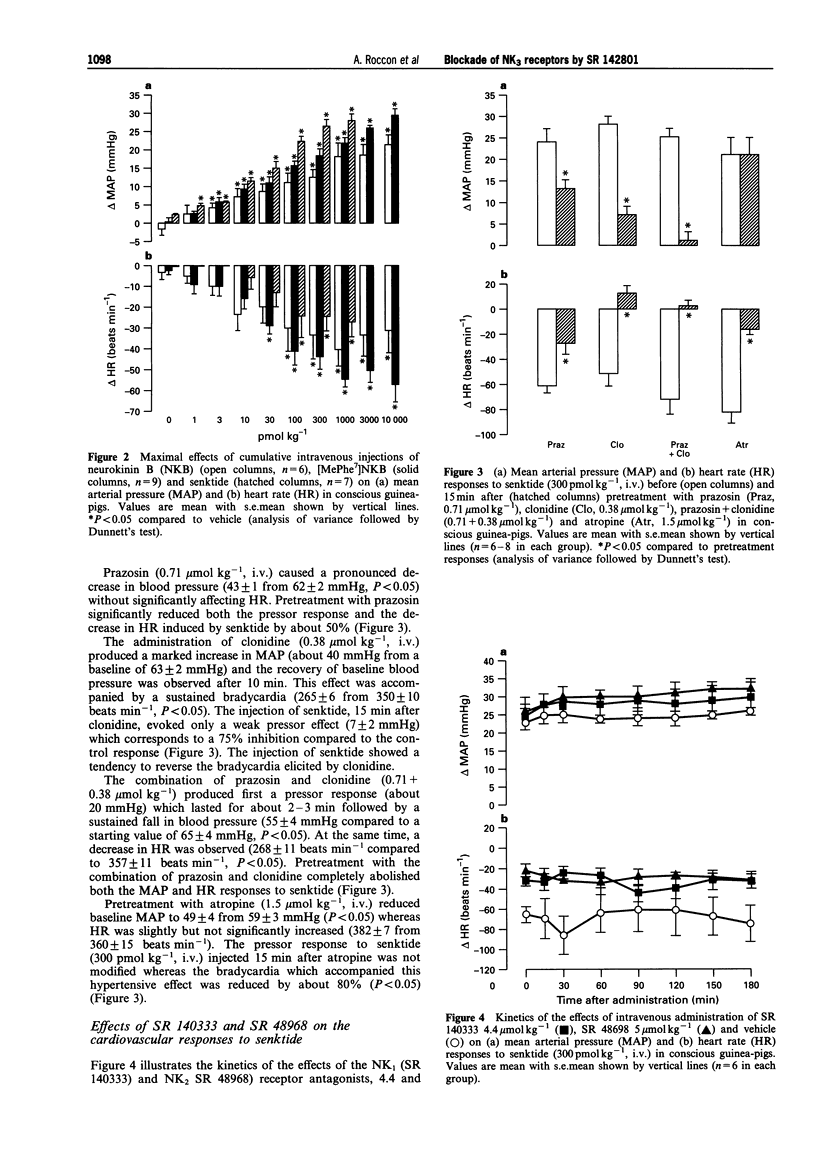
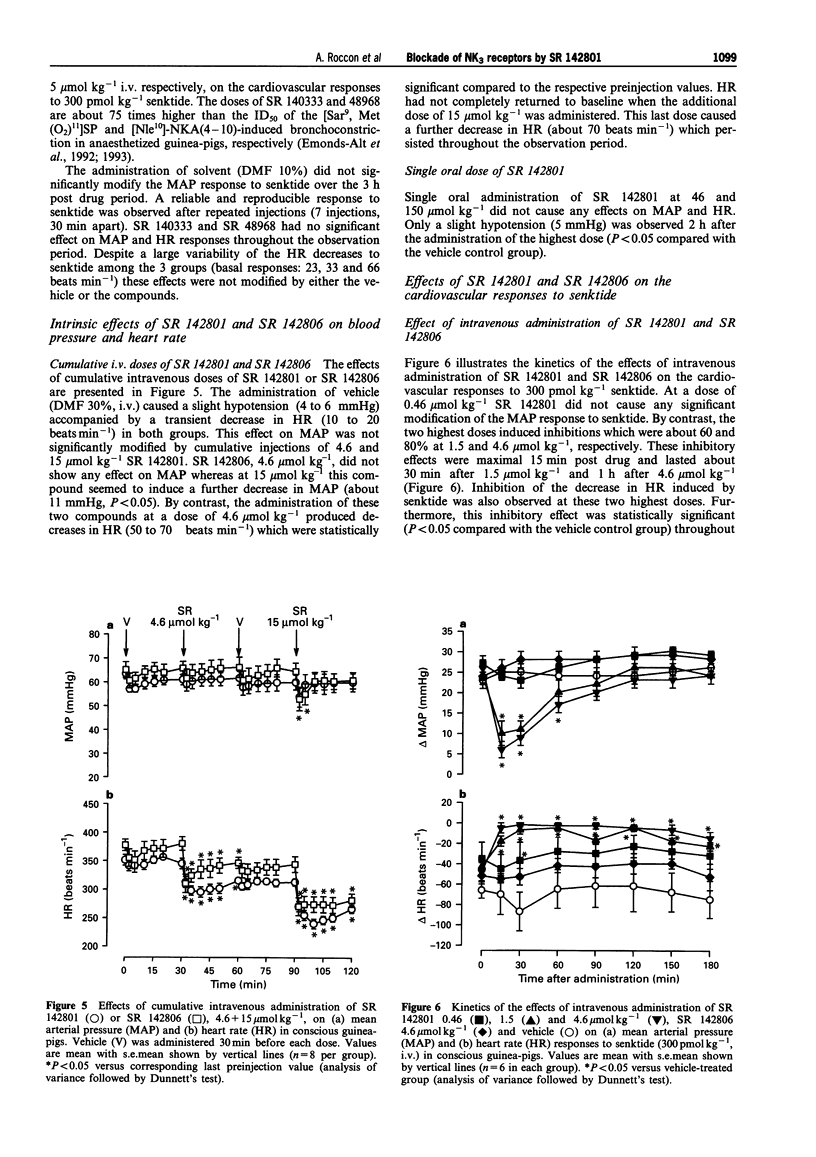
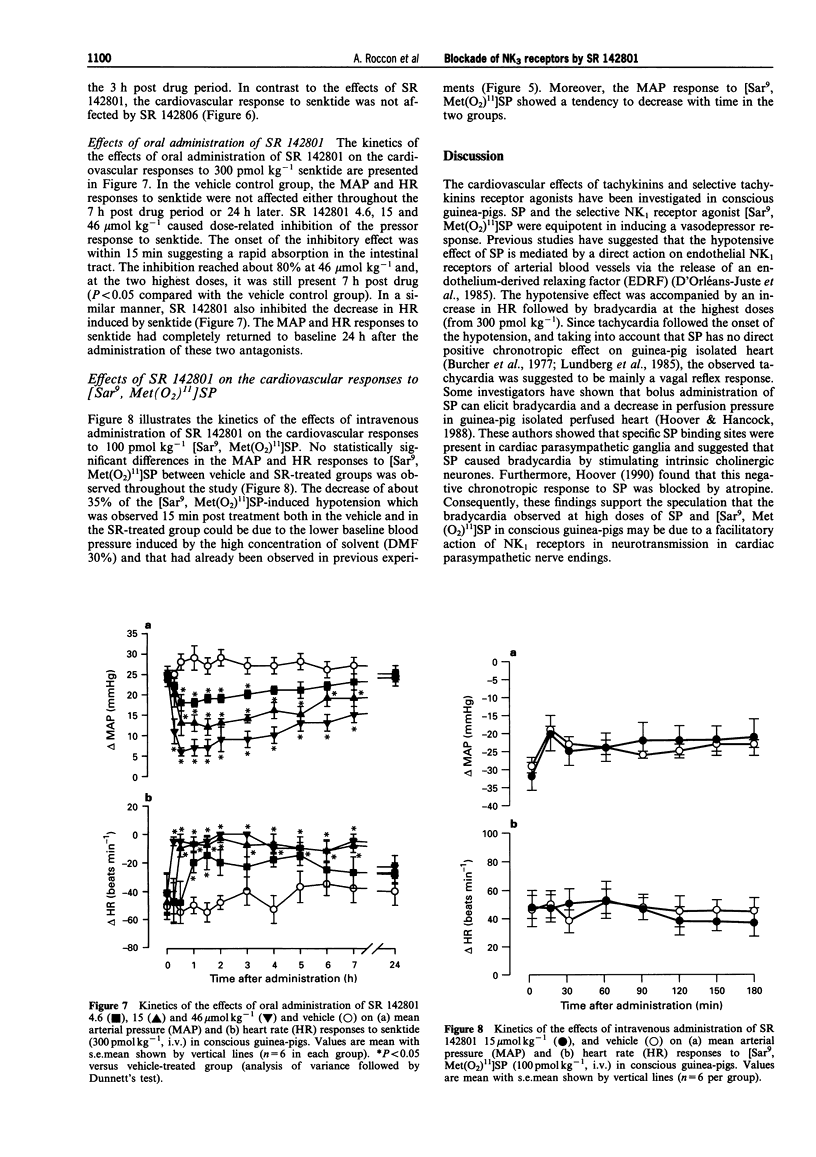
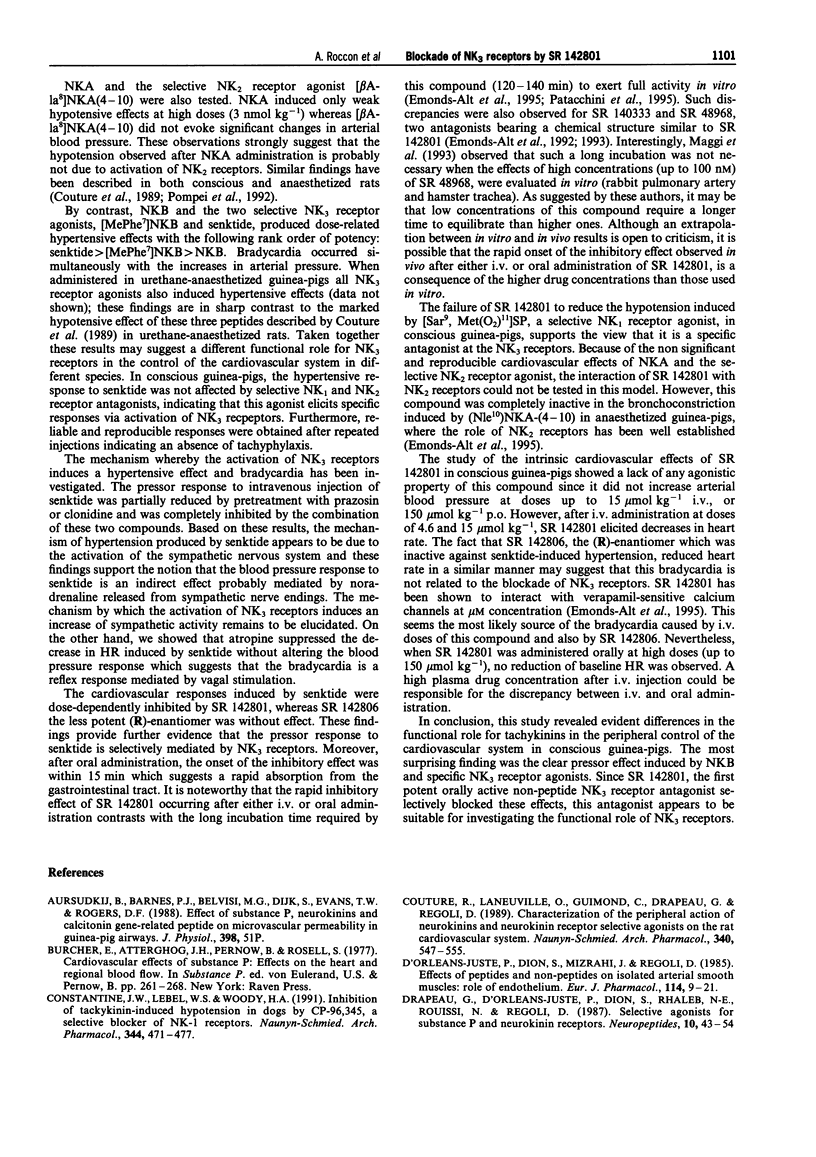
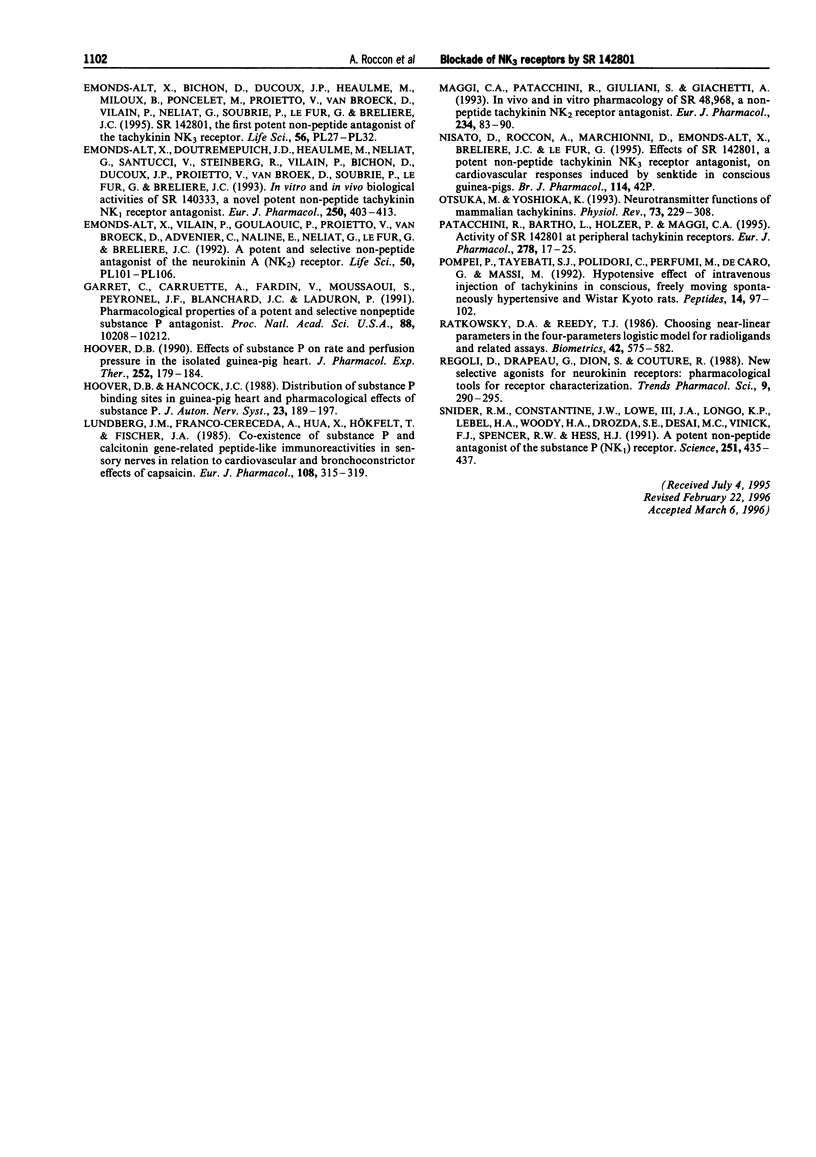
Selected References
These references are in PubMed. This may not be the complete list of references from this article.
- Constantine J. W., Lebel W. S., Woody H. A. Inhibition of tachykinin-induced hypotension in dogs by CP-96,345, a selective blocker of NK-1 receptors. Naunyn Schmiedebergs Arch Pharmacol. 1991 Oct;344(4):471–477. doi: 10.1007/BF00172588. [DOI] [PubMed] [Google Scholar]
- Couture R., Laneuville O., Guimond C., Drapeau G., Regoli D. Characterization of the peripheral action of neurokinins and neurokinin receptor selective agonists on the rat cardiovascular system. Naunyn Schmiedebergs Arch Pharmacol. 1989 Nov;340(5):547–557. doi: 10.1007/BF00260610. [DOI] [PubMed] [Google Scholar]
- D'Orléans-Juste P., Dion S., Mizrahi J., Regoli D. Effects of peptides and non-peptides on isolated arterial smooth muscles: role of endothelium. Eur J Pharmacol. 1985 Aug 7;114(1):9–21. doi: 10.1016/0014-2999(85)90515-1. [DOI] [PubMed] [Google Scholar]
- Drapeau G., D'Orléans-Juste P., Dion S., Rhaleb N. E., Rouissi N. E., Regoli D. Selective agonists for substance P and neurokinin receptors. Neuropeptides. 1987 Jul;10(1):43–54. doi: 10.1016/0143-4179(87)90088-6. [DOI] [PubMed] [Google Scholar]
- Emonds-Alt X., Bichon D., Ducoux J. P., Heaulme M., Miloux B., Poncelet M., Proietto V., Van Broeck D., Vilain P., Neliat G. SR 142801, the first potent non-peptide antagonist of the tachykinin NK3 receptor. Life Sci. 1995;56(1):PL27–PL32. doi: 10.1016/0024-3205(94)00413-m. [DOI] [PubMed] [Google Scholar]
- Emonds-Alt X., Doutremepuich J. D., Heaulme M., Neliat G., Santucci V., Steinberg R., Vilain P., Bichon D., Ducoux J. P., Proietto V. In vitro and in vivo biological activities of SR140333, a novel potent non-peptide tachykinin NK1 receptor antagonist. Eur J Pharmacol. 1993 Dec 21;250(3):403–413. doi: 10.1016/0014-2999(93)90027-f. [DOI] [PubMed] [Google Scholar]
- Emonds-Alt X., Vilain P., Goulaouic P., Proietto V., Van Broeck D., Advenier C., Naline E., Neliat G., Le Fur G., Brelière J. C. A potent and selective non-peptide antagonist of the neurokinin A (NK2) receptor. Life Sci. 1992;50(15):PL101–PL106. doi: 10.1016/0024-3205(92)90352-p. [DOI] [PubMed] [Google Scholar]
- Garret C., Carruette A., Fardin V., Moussaoui S., Peyronel J. F., Blanchard J. C., Laduron P. M. Pharmacological properties of a potent and selective nonpeptide substance P antagonist. Proc Natl Acad Sci U S A. 1991 Nov 15;88(22):10208–10212. doi: 10.1073/pnas.88.22.10208. [DOI] [PMC free article] [PubMed] [Google Scholar]
- Hoover D. B. Effects of substance P on rate and perfusion pressure in the isolated guinea pig heart. J Pharmacol Exp Ther. 1990 Jan;252(1):179–184. [PubMed] [Google Scholar]
- Hoover D. B., Hancock J. C. Distribution of substance P binding sites in guinea-pig heart and pharmacological effects of substance P. J Auton Nerv Syst. 1988 Sep;23(3):189–197. doi: 10.1016/0165-1838(88)90093-8. [DOI] [PubMed] [Google Scholar]
- Lundberg J. M., Franco-Cereceda A., Hua X., Hökfelt T., Fischer J. A. Co-existence of substance P and calcitonin gene-related peptide-like immunoreactivities in sensory nerves in relation to cardiovascular and bronchoconstrictor effects of capsaicin. Eur J Pharmacol. 1985 Feb 5;108(3):315–319. doi: 10.1016/0014-2999(85)90456-x. [DOI] [PubMed] [Google Scholar]
- Maggi C. A., Patacchini R., Giuliani S., Giachetti A. In vivo and in vitro pharmacology of SR 48,968, a non-peptide tachykinin NK2 receptor antagonist. Eur J Pharmacol. 1993 Mar 30;234(1):83–90. doi: 10.1016/0014-2999(93)90709-q. [DOI] [PubMed] [Google Scholar]
- Otsuka M., Yoshioka K. Neurotransmitter functions of mammalian tachykinins. Physiol Rev. 1993 Apr;73(2):229–308. doi: 10.1152/physrev.1993.73.2.229. [DOI] [PubMed] [Google Scholar]
- Patacchini R., Barthò L., Holzer P., Maggi C. A. Activity of SR 142801 at peripheral tachykinin receptors. Eur J Pharmacol. 1995 May 4;278(1):17–25. doi: 10.1016/0014-2999(95)00090-8. [DOI] [PubMed] [Google Scholar]
- Pompei P., Tayebati S. J., Polidori C., Perfumi M., De Caro G., Massi M. Hypotensive effect of intravenous injection of tachykinins in conscious, freely moving spontaneously hypertensive and Wistar Kyoto rats. Peptides. 1993 Jan-Feb;14(1):97–102. doi: 10.1016/0196-9781(93)90015-9. [DOI] [PubMed] [Google Scholar]
- Ratkowsky D. A., Reedy T. J. Choosing near-linear parameters in the four-parameter logistic model for radioligand and related assays. Biometrics. 1986 Sep;42(3):575–582. [PubMed] [Google Scholar]
- Regoli D., Drapeau G., Dion S., Couture R. New selective agonists for neurokinin receptors: pharmacological tools for receptor characterization. Trends Pharmacol Sci. 1988 Aug;9(8):290–295. doi: 10.1016/0165-6147(88)90013-2. [DOI] [PubMed] [Google Scholar]
- Snider R. M., Constantine J. W., Lowe J. A., 3rd, Longo K. P., Lebel W. S., Woody H. A., Drozda S. E., Desai M. C., Vinick F. J., Spencer R. W. A potent nonpeptide antagonist of the substance P (NK1) receptor. Science. 1991 Jan 25;251(4992):435–437. doi: 10.1126/science.1703323. [DOI] [PubMed] [Google Scholar]


